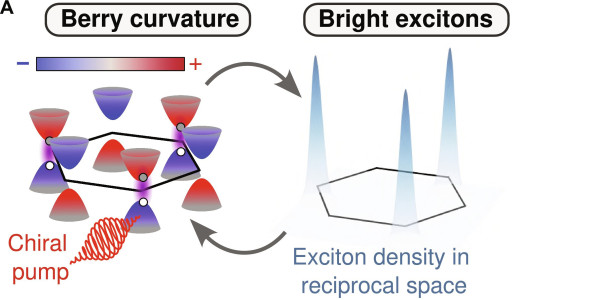A direct probe of the quantum geometry of materials
By Nicola Nosengo - NCCR MARVEL
Many fundamental properties of materials, in particular their electron transport and their optical properties, depend on their quantum geometry, that can be described as the way the wavefunctions of their atoms and electrons evolve in space. One of the most important quantum geometrical properties is the so-called Berry curvature, a particular way by which the laws of quantum mechanics interact with the electronic structure of a material and dictate the possible behavior of its electrons. Despite its importance for understanding the behavior of a solid, measuring the Berry curvature in a solid is extremely challenging. “You can only see indirect manifestations of it, for example when measuring transport” says Michael Schüler, assistant professor at the University of Fribourg and a MARVEL member. ”But the more complicated the material is, the less reliable those indirect probes become”.
To devise a way to directly probe the Berry curvature, a group of experimental and theoretical scientists that includes Schüler as well as MARVEL members Viktor Christiansson and Philipp Werner, also at the University of Fribourg, borrowed an idea first outlined by scientists who study cold atoms. As they write in an article in Science Advances, it involves using relatively simple mathematical tools to measure the rate at which the electrons of a material transition between valence and conduction band. “Because the Berry curvature dictates how often these transitions occur, a momentum-resolved measurement of the transition rate can be used as a direct probe of it” says Schüler.

Illustration of Berry curvature texture and exciton population along with the schematic of the experimental measurement protocol. From Schüler et al., Science Advances (2024)
To do that, the MARVEL team collaborated with scientists at the university of Bordeaux, who resorted to a technique called angle-resolved photoemission spectroscopy (ARPES). It leverages the photoelectric effect, measuring the photoelectrons emitted by the surface of a material when it is hit by photons at the right level of energy to map its electron bands. The method has recently been expanded into time-resolved ARPES, using trains of femtoseconds laser pulses and measuring the resulting emission at an appropriate delay, to track the evolution of electronic band structure and thus the rate of transitions between occupied and non-occupied bands.
For their experiment they picked tungsten diselenide, or WSe2, a 2-dimensional material that, because of its photoelectric properties, they expected to be an ideal testbed. They used an infrared pump to apply polarized pulses to the material. “We want to know how fast the transitions from valence to conduction bands happen, and to measure that we have to somehow drive those transitions, which we do with the pump pulses,” says Schüler. The system goes into an excited states and we probe its photoemission”. The application of pulses results in the creation of bright excitons, that are bound couples of electron and electron holes. “On one side the presence of excitons complicates the picture, but on the other resulted in a very clear signal, which was another reason why this material was ideal for the study” says Schüler.
In parallel to the experiments, the theorists in the group used density functional theory (DFT) and Wannier functions to create a first- principles simulation of the system and make sense of the results.
“The measurement of the Berry curvature we obtained in the end was not really surprising, we already knew how this material behaves” Schüler clarifies. But it served as a proof of concepts of the method. “In principle it could be applied to any material, but it can really shine for 2D materials and for materials with interesting surface properties,”, says Schüler.
In the future, the group wants to apply the method to different exotic materials, in particular topological materials such as Weyl semimetals. “Measuring the Berry curvature would be important to study candidates for these classes of materials” Schüler says. “We want to provide experimentalists with a recipe to measure this property and confirm that what they have in front of them is really a Weyl semimetal, for example”. Recently, there have been cases where DFT calculations have failed to accurately describe the topological properties of materials and a spectroscopic measurement of quantum geometry could help say the final word.
Reference
Samuel Beaulieu et al. ,Berry curvature signatures in chiroptical excitonic transitions. Sci. Adv. 10,eadk3897(2024).DOI:10.1126/sciadv.adk3897
Low-volume newsletters, targeted to the scientific and industrial communities.
Subscribe to our newsletter